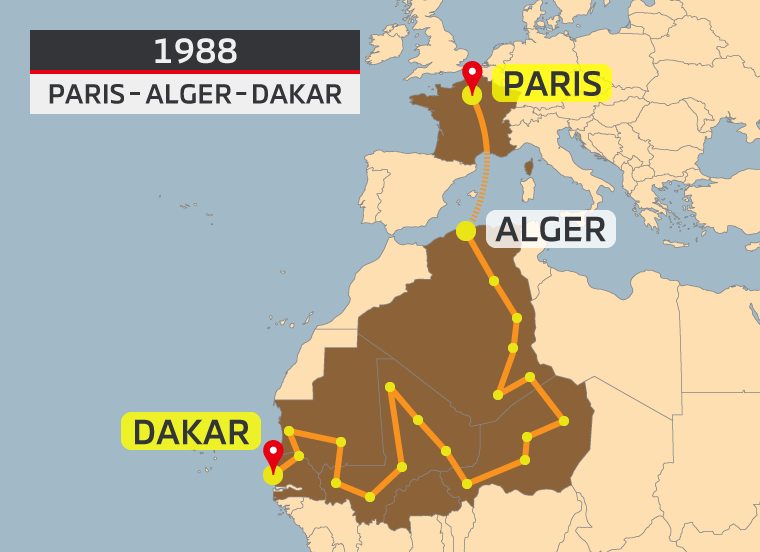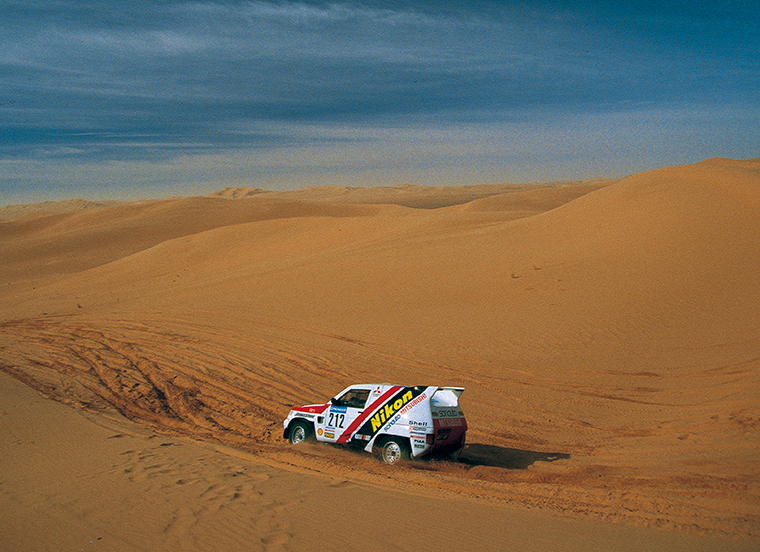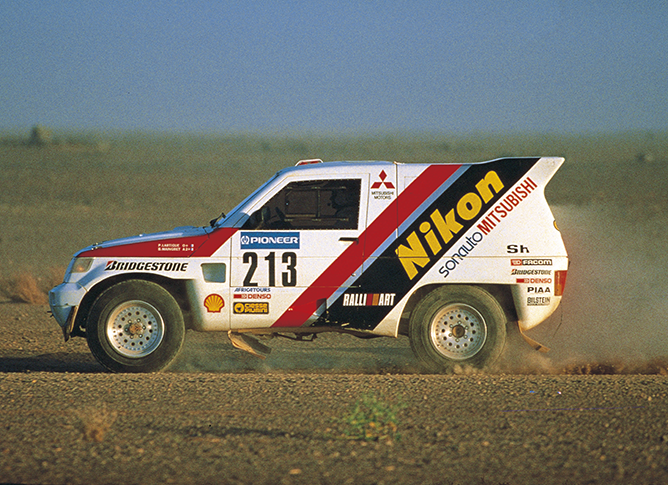
The MITSUBISHI MOTORS team started improving the PAJERO/MONTERO Prototypes to meet the increased competitive speeds required for the Dakar Rally. The extension of the wheelbase and increase of the suspension stroke improved straight-line stability and road handling. The engine generated a maximum output of 275PS and a maximum torque of 40.4 kg-m by turbocharging the engine along with increasing the compression ratio. In addition, the body was also aerodynamically designed, allowing the car to achieve a maximum speed of 200 km/h. The prototype was conceived at MITSUBISH MOTORS’ Passenger Car Technology Center in Okazaki City (Aichi Prefecture) in Japan. Using ¼ scale clay model, they designed what’s called an "Egg-shape Body" in which the rear portion is rounded. The model was put through a wind tunnel which showed that the drag coefficient (Cd) value was reduced by about 20%, which allowed the car to have the potential to reach a maximum speed of 220 km/h according to calculations. However, even with such improvements, it was also a fact that, being based on the ladder frame structure of mass-produced vehicles, the car did not reach the level of the Peugeot prototypes that used a tubular frame structure.


The 1988 prototypes were driven by Andrew Cowan and Pierre Lartigue of France. Japan’s Shinozuka and Frenchman Bernard Béguin drove the 1987-spec prototypes. Hiroshi Masuoka also drove a works car for the event. The Peugeot factory team fielded four powerful prototypes, which included the new 405 driven by Ari Vatanen and Henri Pescarolo of France and the 205 Turbo 16 driven by World Rally champion Juha Kankkunen of Finland and Alain Ambrosino of France. In addition, competitive teams driving Range Rover, Porsche, Lada and Mercedes Benz attracted considerable attention, with a record 603 vehicles participating, the largest number so far in the history of the Dakar Rally.

The course of the 10th Dakar totaled 12,874 km, of which the competitive stages (SS) amounted to 6,884 km. It was the last year that the event started from Versailles, heading to southern France before landing in Algiers. After reaching the North African coast, the event headed southward through Algeria into Niger through Mali and Mauritania after a rest day in Agadez and finally reaching the finish at Lac Rose in Senegal, a route that was unchanged from previous years. However, the course proved to be arduous as more than 100 vehicles retired on the first day in Algeria. In addition, a total of seven fatal accidents occurred, mainly in high-speed SS sections. Four special stages were cancelled due to sandstorms. The rally was dominated by Peugeot from the beginning, but Vatanen’s vehicle was stolen at the bivouac in Bamako, Mali. Although the car was later returned, he couldn't start on time and found himself excluded from the rally. Kankkunen, who was making his first appearance at the event, took the lead and won the rally, confirming the endurance and speed he displayed in his participation in the WRC. Shinozuka took second overall, one place higher than the previous year, making his way up from the lower positions. On the other hand, Cowan and Lartigue were both fighting for the lead from the beginning, but were forced to retire due to overheating. In addition, the PAJERO/MONTERO scored striking results, with the Dutch Tijsterman couple achieving an impressive eighth place overall in a works vehicle. The PAJERO/MONTEROs also did well in the modified production car class, the private teams monopolizing the first four places. A total of 302 vehicles completed the grueling event, only about 50% of the total of participants.
 The MITSUBISHI MOTORS team started improving the PAJERO/MONTERO Prototypes to meet the increased competitive speeds required for the Dakar Rally. The extension of the wheelbase and increase of the suspension stroke improved straight-line stability and road handling. The engine generated a maximum output of 275PS and a maximum torque of 40.4 kg-m by turbocharging the engine along with increasing the compression ratio. In addition, the body was also aerodynamically designed, allowing the car to achieve a maximum speed of 200 km/h. The prototype was conceived at MITSUBISH MOTORS’ Passenger Car Technology Center in Okazaki City (Aichi Prefecture) in Japan. Using ¼ scale clay model, they designed what’s called an "Egg-shape Body" in which the rear portion is rounded. The model was put through a wind tunnel which showed that the drag coefficient (Cd) value was reduced by about 20%, which allowed the car to have the potential to reach a maximum speed of 220 km/h according to calculations. However, even with such improvements, it was also a fact that, being based on the ladder frame structure of mass-produced vehicles, the car did not reach the level of the Peugeot prototypes that used a tubular frame structure.
The MITSUBISHI MOTORS team started improving the PAJERO/MONTERO Prototypes to meet the increased competitive speeds required for the Dakar Rally. The extension of the wheelbase and increase of the suspension stroke improved straight-line stability and road handling. The engine generated a maximum output of 275PS and a maximum torque of 40.4 kg-m by turbocharging the engine along with increasing the compression ratio. In addition, the body was also aerodynamically designed, allowing the car to achieve a maximum speed of 200 km/h. The prototype was conceived at MITSUBISH MOTORS’ Passenger Car Technology Center in Okazaki City (Aichi Prefecture) in Japan. Using ¼ scale clay model, they designed what’s called an "Egg-shape Body" in which the rear portion is rounded. The model was put through a wind tunnel which showed that the drag coefficient (Cd) value was reduced by about 20%, which allowed the car to have the potential to reach a maximum speed of 220 km/h according to calculations. However, even with such improvements, it was also a fact that, being based on the ladder frame structure of mass-produced vehicles, the car did not reach the level of the Peugeot prototypes that used a tubular frame structure.

 The 1988 prototypes were driven by Andrew Cowan and Pierre Lartigue of France. Japan’s Shinozuka and Frenchman Bernard Béguin drove the 1987-spec prototypes. Hiroshi Masuoka also drove a works car for the event. The Peugeot factory team fielded four powerful prototypes, which included the new 405 driven by Ari Vatanen and Henri Pescarolo of France and the 205 Turbo 16 driven by World Rally champion Juha Kankkunen of Finland and Alain Ambrosino of France. In addition, competitive teams driving Range Rover, Porsche, Lada and Mercedes Benz attracted considerable attention, with a record 603 vehicles participating, the largest number so far in the history of the Dakar Rally.
The 1988 prototypes were driven by Andrew Cowan and Pierre Lartigue of France. Japan’s Shinozuka and Frenchman Bernard Béguin drove the 1987-spec prototypes. Hiroshi Masuoka also drove a works car for the event. The Peugeot factory team fielded four powerful prototypes, which included the new 405 driven by Ari Vatanen and Henri Pescarolo of France and the 205 Turbo 16 driven by World Rally champion Juha Kankkunen of Finland and Alain Ambrosino of France. In addition, competitive teams driving Range Rover, Porsche, Lada and Mercedes Benz attracted considerable attention, with a record 603 vehicles participating, the largest number so far in the history of the Dakar Rally.

